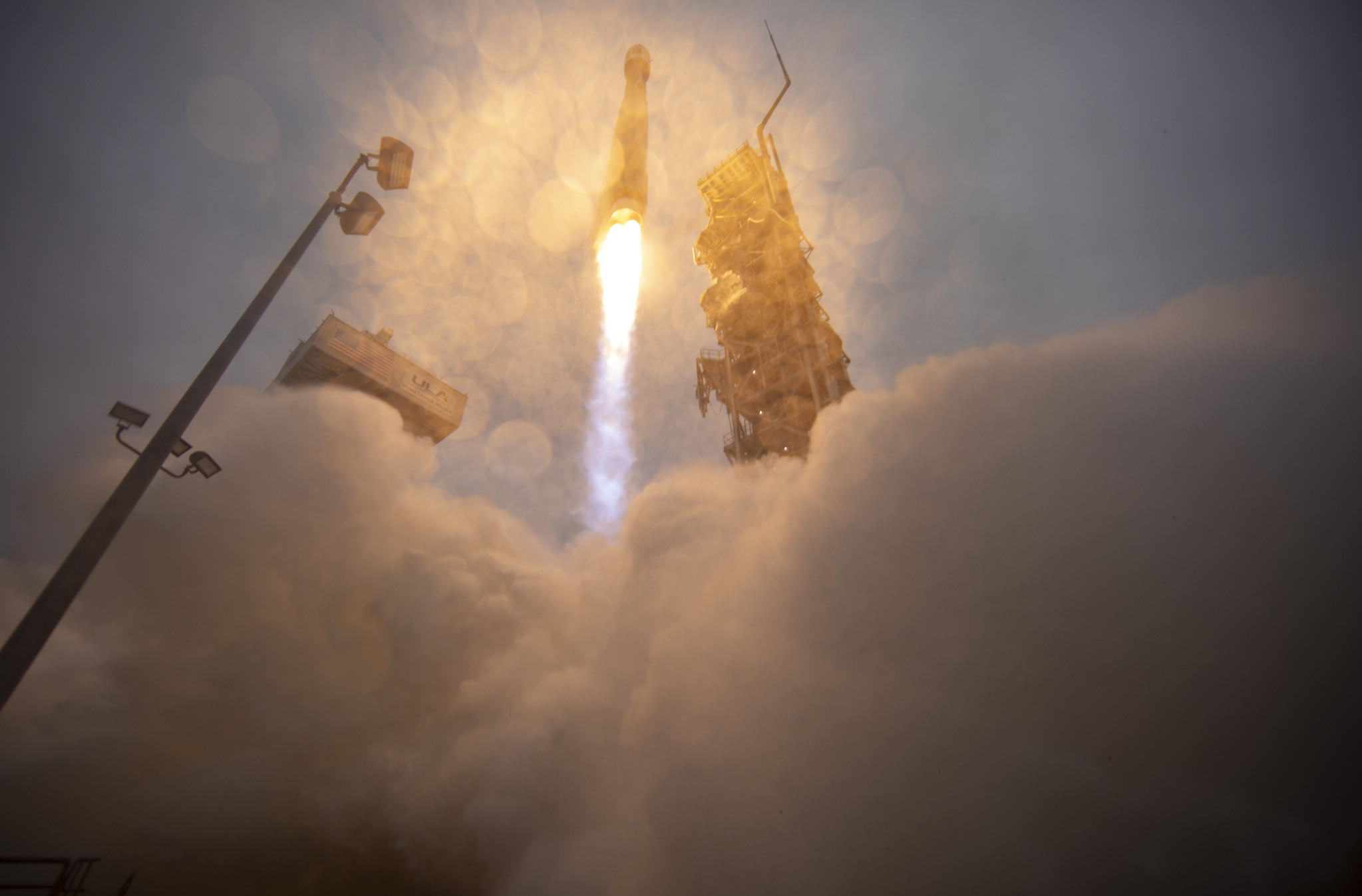NASA launches powerful Landsat 9 satellite to monitor climate change, forest cover and more
The Landsat program's 50-year legacy of Earth observation continues.
NASA's newest Earth-observing satellite has made it to space.
The spacecraft, called Landsat 9, will help extend the 50-year continuous record of global imagery collected by the Landsat family of satellites since 1972.
Perched atop a United Launch Alliance (ULA) Atlas V rocket, Landsat 9 blasted off from Vandenberg Space Force Base in California right on time at 2:12 p.m. EDT (11:12 local time and 1812 GMT) today (Sept. 27), marking the installation's 2,000th launch since 1958. The spacecraft separated from its rocket ride as planned, about 80 minutes after liftoff.
Weather forecasters at the 30th Space Delta predicted favorable conditions for liftoff, and Mother Nature did not disappoint — though the Atlas V quickly disappeared into a thick obscuring marine layer, a common feature of the Central California coast at this time of year.
Today's launch was originally scheduled for Sept. 16. It was delayed a week, however, due to a high demand for liquid oxygen to help treat COVID-19 patients. The company that delivers needed liquid nitrogen to Vandenberg retasked to haul more medical liquid oxygen instead, affecting the Landsat 9 launch schedule, NASA officials said. Weather concerns then pushed the launch back a few more days.
In photos: Earth pictures from space: Landsat satellite legacy



Landsat 9
NASA was in charge of building and launching Landsat 9, though the United States Geological Survey will operate the satellite and process its data.
Get the Space.com Newsletter
Breaking space news, the latest updates on rocket launches, skywatching events and more!
The mission, which costs around $750 million, is the ninth in the Landsat program and will continue the program's role of monitoring and managing land resources. Landsat 9 will replace the aging Landsat 7 satellite, which has been in orbit since 1999, and will work in tandem with Landsat 8, which was launched in 2013. Together, the duo will image the entire Earth every eight days.
Landsat 9 will eventually settle into an orbit that takes it over the planet's poles, at an altitude of about 438 miles (705 kilometers). The satellite carries two scientific instruments — the Operational Land Imager 2 (OLI-2) and the Thermal Infrared Sensor 2 (TIRS-2) — that can detect minute changes in the world's lakes, rivers and forests by analyzing light reflected from the planet in multiple wavelengths.
According to mission scientists, Landsat is the most economically impactful Earth science program. Landsat 8 and Landsat 9, working in tandem, will help track urban sprawl, forest cover and the retreat of glaciers, among other features and phenomena.
"Landsat tells us about the Earth's vegetation, land use, coastlines and surface water, just to name a few," Karen St. Germain, head of NASA's Earth Science Division, said in a prelaunch briefing. "When combined with other Earth science missions, that can tell us what is happening and also why."
"We've assembled an amazing history of how the planet has changed over the last half century," added Jeff Masek, NASA's Landsat 9 project scientist.
"For example, we're able to see the natural disturbances that occur, (such as) fires, hurricanes, and insect outbreaks, and then the long-term recovery of ecosystems that takes place for decades after that," Masek said.
The Landsat family of satellites has been imaging the globe since 1972, providing researchers around the world with a continuous data record of the planet's ecosystems.
The data was made public in 2008 and is an invaluable resource for monitoring climate change.
"We're able to look specifically at climate and climate-change impacts on ecosystems," Malek said. "We've mapped areas of increased plant cover at high latitudes due to a warming climate. We've also seen areas of vegetation decline in water-limited semi-arid environments."
Related: Earth is hotter than ever — So what happens next?
Mighty Atlas V
Today's launch marked the 145th flight of an Atlas V to date and the 88th flight of the rocket for NASA. In August, ULA announced that it had only 29 Atlas V rockets left in its fleet and that all of those launch vehicles already have confirmed missions.
The Atlas V flew today in its simplest configuration: the 401. That means the Landsat 9 satellite was tucked into a 13-foot-wide (4 meters) payload fairing, and the rocket relied on a single-engine Centaur upper stage, with no solid rocket boosters, to propel it to space.
Joining Landsat 9 for the ride today were four tiny cubesats, which will deploy from the launcher after Landsat 9 has been deposited in space. They will perform a variety of science investigations, including taking measurements of the solar wind and ultraviolet light emanating from stars.
Up next for Atlas V is the launch of another key science mission. On Oct. 16, the Lucy spacecraft will blast off atop a different Atlas V rocket, bound for a journey to the asteroid belt where it will study multiple Trojan asteroids in order to help scientists better understand how planets form.
Lucy's rocket ride was originally supposed to ferry Boeing's Starliner spacecraft to space in August. However, Starliner was forced to return to the factory after several valves in its propulsion system were stuck closed. The valve issue has delayed the capsule's uncrewed test flight to the International Space Station significantly, perhaps until next year.
Teams at ULA had to reconfigure the rocket to get it ready to fly Lucy next month. That's because Lucy will rely on a single Centaur engine, whereas Starliner requires a dual-engine Centaur upper stage.
There is one more Atlas V rocket scheduled to fly from Vandenberg: The launch of the National Oceanic and Atmospheric Administration's Joint Polar Satellite System 2 satellite is slated for next September.
ULA is working toward the debut of its next rocket, the Vulcan Centaur. Designed to replace the Atlas V, Vulcan is scheduled to come online sometime in 2022.
Record-setting mission
Today's flight marked the 2,000th launch from Vandenberg since 1958. It was the 300th Atlas launch, which includes all iterations of the vehicle, not just the Atlas V.
That first launch, which occurred on Dec. 16, 1958, carried a Thor missile, followed by a Thor/Agena in 1959 that lofted Discover 1, the first polar Earth-orbiting satellite.
Vandenberg is predominately used for polar launches that target high-inclination orbits. Such orbits are perfect for most Earth-observing satellites as well as some communications missions.
Following the final West Coast Atlas V launch next year, ULA will reconfigure its Vandenberg launch pad (SLC-3E) for its upcoming Vulcan Centaur rocket.
Editor's note: This story was updated at 3:35 p.m. EDT (1935 GMT) with news of Landsat 9's successful deployment.
Follow Amy Thompson on Twitter @astrogingersnap. Follow us on Twitter @Spacedotcom or Facebook.
Join our Space Forums to keep talking space on the latest missions, night sky and more! And if you have a news tip, correction or comment, let us know at: community@space.com.

Amy Thompson is a Florida-based space and science journalist, who joined Space.com as a contributing writer in 2015. She's passionate about all things space and is a huge science and science-fiction geek. Star Wars is her favorite fandom, with that sassy little droid, R2D2 being her favorite. She studied science at the University of Florida, earning a degree in microbiology. Her work has also been published in Newsweek, VICE, Smithsonian, and many more. Now she chases rockets, writing about launches, commercial space, space station science, and everything in between.









